Latest update 4 February 2007
Description of H-3 helmet from NAVPERS 10358-A, Parachute Rigger 3 & 2 from
around 1960
Original Gentex H-3 user instruction
sheet, 1952
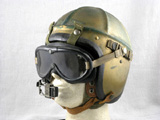
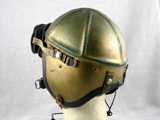
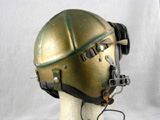
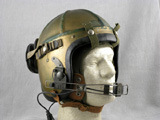
H-3 helmet made by Gentex. Apart from the four stabilising straps attached to the outer helmet shell fore and aft,
this helmet is in the original, early configuration. Pictures © Bluelight
By 1949 the US Navy was using two types of protective
helmets for use by pilots of high speed aircraft, a Navy design (H-1) and one developed by
the Air Force (P-1). Both have laminated fabric and plastic outer shells and utilize
either sponge rubber liner (H-1) or a suspension system (P-1) to protect the wearer’s
head. By April 1949 these helmets had been or were being issued to all jet pilots and
pilots of Grumman F8F Bearcat and Vought F4U Corsair aircraft who required them. Neither
of these designs was seen as the final word, however, and Bureau of Aeronautics (BuAer)
was working on two types. One would be a helmet which would fit over the standard flying
helmet (H-3). Microphone and oxygen mask and headphones would be attached to the regular
helmet so they would not be lost in the event of bailout. It had been found that in every
case of bailout the helmet was lost. They would be designed so that they would come off in
such event without a tight chin strap choking or causing injury to the pilot. The second
type under development incorporated all the necessary gear on one helmet (H-2). Of the two
designs the two-piece helmet showed more promise.
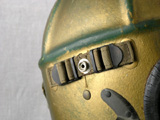
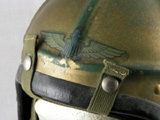
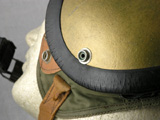
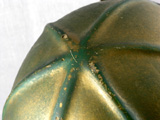
Far left: The two buckles for adjusting the
headband. The male snap is for attaching goggles as shown in the
photos in the top row. Left: Close-up of the two front stabilising straps
introduced to keep the outer helmet in place
during catapult assisted takeoff, during arrested landings, and high "g"
menoeuvres. They also prevented the loss
of the outer helmet in case of an ejection. Right: The single snap for
attaching the leather shear strap that originally
allowed the outer helmet to break away during ejection. Far right: One of
the surefire ways of distinguishing
between an H-3 and an H-4 is the crown where reinforcement ridges meet. On the H-3 the
ridges just cross each
other as a six-pointed star whereas the H-4 has a large round elevated area where the
ridges meet.
Pictures © Bluelight
By April 1951 the H-3 had been designated as the standard
protective helmet and 10.000 helmets were being procured. This first two-piece helmet, the
H-3, featured a "breakaway" shell, with a leather shear strap (later modified
with a metal ball-hook) designed to permit the outer shell to carry away under high
wind-blast forces.
The helmets were painted gold because it was determined that this colour provided
efficient thermal protection against solar radiation. Other colours would have a tendency
to make the helmet warm and therefore uncomfortable to the pilot. It was therefore
recommended that no markings that covered larger areas of the helmet shells were applied.
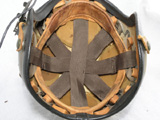
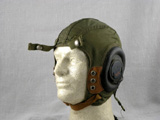
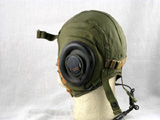
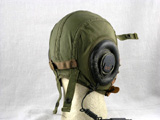
Far left: The inside of the H-3 helmet
outer shell. Left, Right and Far right:
The original early H-3 innerliner,
here modified with stabilising straps fore and aft. Pictures © Bluelight
A large number of H-3 helmets were introduced to the
fleet, and were later modified with fore and aft stabilising straps connecting liner and
shell, and solid, non-shear chinstrap. This stabilising strap arrangement came about when
thinking again turned to keeping the helmet attached to the liner, and this modification
was widely applied also to the H-4, which became the standard anti-buffet helmet from
around 1954 onwards. This did not mean that the H-3 was taken out of service. The two
types continued side by side as a sort of Duke's mixture of H-4s and H-3s having H-4
liners. From late 1956 the APH-5 helmet became the primary helmet for high performance
aircraft so the H-3 and H-4 were relegated to less glorious use. Both the H-3 and the H-4
were still mentioned in the 1964-dated NAVPERS 10358-B PR training manual. By that time
the H-3 and H-4 helmets were primarily used by crewmen in multi-place aircraft. They were
no longer under procurement; and when replacement was necessary, they would be replaced by
either the SPH-2, the BPH-2, or one of the APH types, whichever was applicable. The H-3
and H-4 were no longer mentioned in the 1967-dated NAVPERS 10358-C. It may therefore
safely be assumed that for all intents and purposes the H-3 and H-4 disappeared from USN
service between 1964 and 1967.
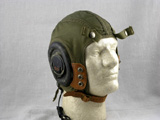
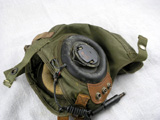
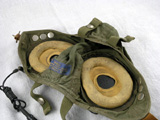
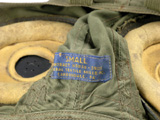
Apart from the label, two features distinguish the original
early H-3 liner. One is the light yellow chamois-covered
earpads (Right and Far right) and the other is the
leather oxygen mask attachment pads with three male studs
(Far left and Left). These studs were used before the US
Navy introduced Pull-the-Dot snaps for better oxygen
mask retention. This liner has threaded studs with small screws for oxygen mask retention
- the same system that
was used by the USAF on their P-series helmets. Pictures © Bluelight
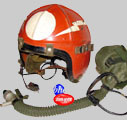
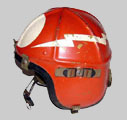
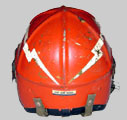
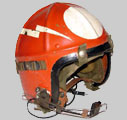
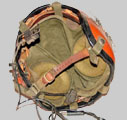
H-3 helmet with custom artwork from an unidentified
squadron. It has been modified with a later liner with only two
male studs on each side for oxygen mask retention. Pictures © Michael Ewasko (eBay seller
'bluzinger')
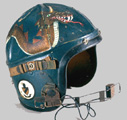
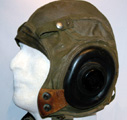
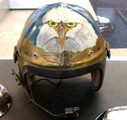
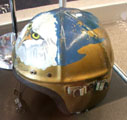
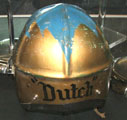
Two of the H-3 helmets in the holdings of the US National
Museum of Naval Aviation in Pensacola, Florida. Far left
and Left: According to the museum website this helmet and liner were worn
by Ensign Alan R. Bedford of VF-151
"Black Knights" while flying F9F Panthers during the Korean War. The liner is
not the original H-3 design so it is
likely that Bedford used the helmet after the Korean War as well. Pictures © US Navy Left,
Right and Far right:
H-3 with bald-headed eagle artwork and named to "Dutch". Pictures © Shark.